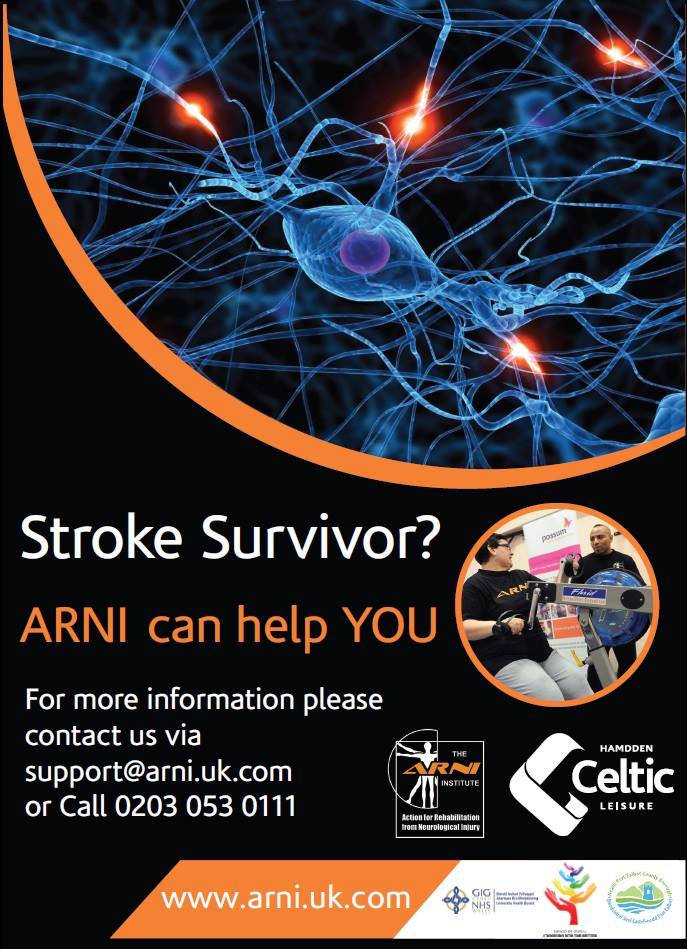THE ARNI INSTITUTE STROKE REHABILITATION AND EXERCISE PROGRAMME
The ‘ARNI Approach’ is an exciting development in the field of stroke rehabilitation, that has an international reputation for serious results in terms of it ability to assist stroke survivors to regain function and strength after stroke, using up to date principles of neuroplasticity. See World Stroke Congress Abstract and clinical research concerning the relative efficacy of the ARNI Intervention.
ARNI Stroke Charity (and ARNI Institute for Stroke Rehabilitation, its teaching element) is run at ARNI Central by volunteers, including its Founder, Dr Tom Balchin, a a successful stroke survivor.
It was formed in 2001 in response to the demand throughout the UK from stroke survivors, who were often found to state that felt they were ‘stuck in limbo’ after formal therapy ‘came to an end’. This situation/response continues, as you probably know.
ARNI supports the hospitals by providing a means of professional development for therapists and specialist physical instructors around the UK who wish to work (or are already working) in the area of rehabilitating stroke survivors, which meet the quality standards of the Stroke-Specific Education Framework.
Stroke survivors want to be more independent but usually need some help to do so. ARNI matches stroke survivors with one of its 150 or so therapists and specialist physical instructors who usually charge a nominal amount for personal care.
The ARNI Approach is currently the adopted model for rehabilitation & exercise after stroke for some UK Counties in association with the NHS and Stroke Association. Click this Clinical Research button for the latest research into ARNI Stroke Exercise and Rehabilitation.
Our aim is to take you from the stage where an NHS or other therapist becomes unavailable for whatever reason, to the stage where you can go on to make all ‘retraining’ you do to help yourself just part of your activities of your daily life (ADLs).
ARNI Instructors will teach you the ARNI evidence-based AND innovative functional ‘retraining’ strategies, customising them as appropriate.. and will support you increasingly to take as much charge of your own physical recovery. We also have SLTs on our team – a number of whom are trained to provide support with cognitive limitations and swallowing (please
1) What is the ARNI Programme?
First of all, please read about what ARNI is, and then below, why we exist.
The ARNI Approach to stroke recovery encompasses:
- Functional Task training
- Physical coping strategies
- Stroke-specific resistance training
- The design of self-recovery programmes with the aim of self-reliance.
- Additions: SLT, Cognition & Dysphagia.
The ARNI programme offers a tailored training regime for each individual, which revolves around functional movement with task-related exercises. ARNI will teach you the importance of encouraging brain plasticity with the practice that you do. The ARNI Approach is the first comprehensive collection of reality-based techniques grounded in contemporary neurological research perspectives that is available for you to access after the assistance of the therapist(s).
This dedicated approach is completely unique; it has been designed specifically for the needs of the stroke survivor with partial paralysis who feels that they cannot find any way to recuperate further using more traditional approaches. It relies on the effects of a combination of neurologically complementary strategies.
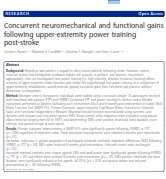 Traditional therapy has for many years now been challenged by evidence revealing that task specific strength training and exercises, aquatic therapy, CIMT, intensive partial weight bearing treadmill, orthoses (particularly active orthoses using FES), and the establishment of some helpful, functional and temporary compensatory modes may be more effective methods to focus on. And that higher repetition rates (where appropriate and possible, where the survivor is active rather than passive during training) has the power to drive neuroplasticity.
Traditional therapy has for many years now been challenged by evidence revealing that task specific strength training and exercises, aquatic therapy, CIMT, intensive partial weight bearing treadmill, orthoses (particularly active orthoses using FES), and the establishment of some helpful, functional and temporary compensatory modes may be more effective methods to focus on. And that higher repetition rates (where appropriate and possible, where the survivor is active rather than passive during training) has the power to drive neuroplasticity.
For example, click on the paper to the left to read about the efficacy of power training plus functional task training (Patten et al. Journal of NeuroEngineering and Rehabilitation 2013, 10:1) which concludes ‘these results contribute to an evolving body of contemporary evidence regarding the efficacy of high-intensity training in neurorehabilitation and the physiological mechanisms that mediate neural recovery’.
Importantly, it is presumed that each case will be different and thus will require a different emphasis. As the training is so personalised it offers a unique chance to benefit from ‘retraining’ that is normally inaccessible to the average stroke survivor.
The ARNI Institute exists for YOU. We know that, by accessing our UK Instructors, you should expect over time to:
- Correct your balance and posture
- Improve your co-ordination and timing
- Increase your flexibility and stamina
- Increase your muscular, tendon and ligament strength
- Increase your confidence and remove your fear of the consequences of exercising
- Increase your ability to perform everyday tasks and progressively more self-sufficient
- Become productive in an occupation or past-time
- Increase your self-esteem and be happy with life
2) How does ARNI work?
Current neurological scientific research supports the premise that your brain has the ability to positively adapt to assist recovery of lost function after stroke.
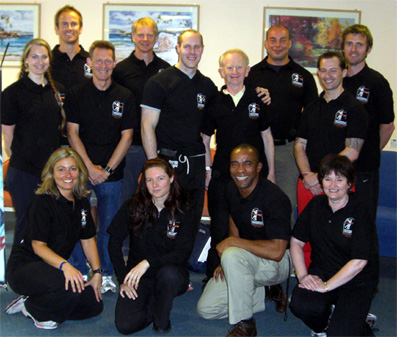 Probably one of the biggest advantages you have as a stroke survivor is your brain’s astonishing capacity for neuroplasticity, Ask your current therapist about it. The notion of brain plasticity is one of the most extraordinary discoveries of the twentieth century. It suggests that the location of a given function in the brain (for example, speech) can move to another area of the brain. In the case of stroke, brain plasticity refers to healthy brain cells taking over the functions of damaged brain cells. This means that certain lost functions, such as speech and language, may re-emerge as the result of intensive rehabilitation. The idea of the brain being able to ‘adapt’ to a traumatic event is new and optimistic.
Probably one of the biggest advantages you have as a stroke survivor is your brain’s astonishing capacity for neuroplasticity, Ask your current therapist about it. The notion of brain plasticity is one of the most extraordinary discoveries of the twentieth century. It suggests that the location of a given function in the brain (for example, speech) can move to another area of the brain. In the case of stroke, brain plasticity refers to healthy brain cells taking over the functions of damaged brain cells. This means that certain lost functions, such as speech and language, may re-emerge as the result of intensive rehabilitation. The idea of the brain being able to ‘adapt’ to a traumatic event is new and optimistic.
So, why is that more people are not getting more movement back again after stroke? The number one reason is physiological. For instance, stroke causes a number of changes with the body that must be tackled incrementally because stroke survivors frequently have insufficient underlying motor activity to start the kind of task related practice they need to do.
This system contains an abundance of techniques which are designed to prime the body for task-related practice. Often, therapists help stroke survivors to get to their feet and walk again after brain injury and many achieve great successes in the very short time they have to work with them in the acute/chronic stages. However we often see stroke survivors who find it hard to move on from sticks and orthotics… and other aids to functional movement and many feel they can achieve better function in their paretic (weak) hand if given a chance to do so. We can help in this situation.
With your ARNI Instructor:
The system you are about to learn has been refined over a period of 24 years with stroke survivors of varying ages, type and severity of stroke… and of time from injury. With your trainer, the application of individual trial and error is required in order to see what can be done using the specialised ARNI rehabilitation exercises and strategies… and to understand what goals can be reached. All training given will be appropriate to the individual, even though you may be working in a group class.
With your trainer, the application of individual trial and error is required in order to see what can be done using the specialised ARNI techniques and to understand what goals can be reached. You need to be working ‘on the edges’ of your current ability to stimulate maximum neuroplasticity.
Your Instructor will show you progressively more advanced exercises including an introduction concerning how you can prepare your body for rigorous weight training, if that is a further goal of yours. Usually only body-weight resistance work is used by Instructors, although the ARNI training syllabus incorporates just 2 highly effective techniques for compound resistance training (the deadlift and squat). Both are unusual variations of the usual techniques, as we have adapted them for stroke survivors’ limitations.
Your training will finish when you find you no longer need the help of our specialists, but you can continue to use their gyms or training areas, or find another outlet in your own area, however old you are, to continually be active in order to maintain and add to your gains in terms of movement, stability, strength and conditioning.
HARD WORK? Well, yes…
You might find yourself wondering by now whether you could even think about doing something like this especially as we will tell you it requires a lot of hard work. Actually it is progressive hard work. There is a big difference. We will surely push you, but within your own limitations, which are of course going to be moving targets.
The rehabilitative movements are done at a very basic level, designed especially for the trainee to understand how THEY can start to take charge of increasing action control (eg., enhance balance, reduce spasticity in upper limb, control the effects of drop-foot) Likewise, essential fitness and resistance training is carried out at a low level with great care in exercise selection and attention to form. This is NOT treatment by passive positioning. This is you DOING it. This is you using your plastic brain and regaining movement.
3) Why is ARNI Functional Training approach needed in the UK? According to the research:
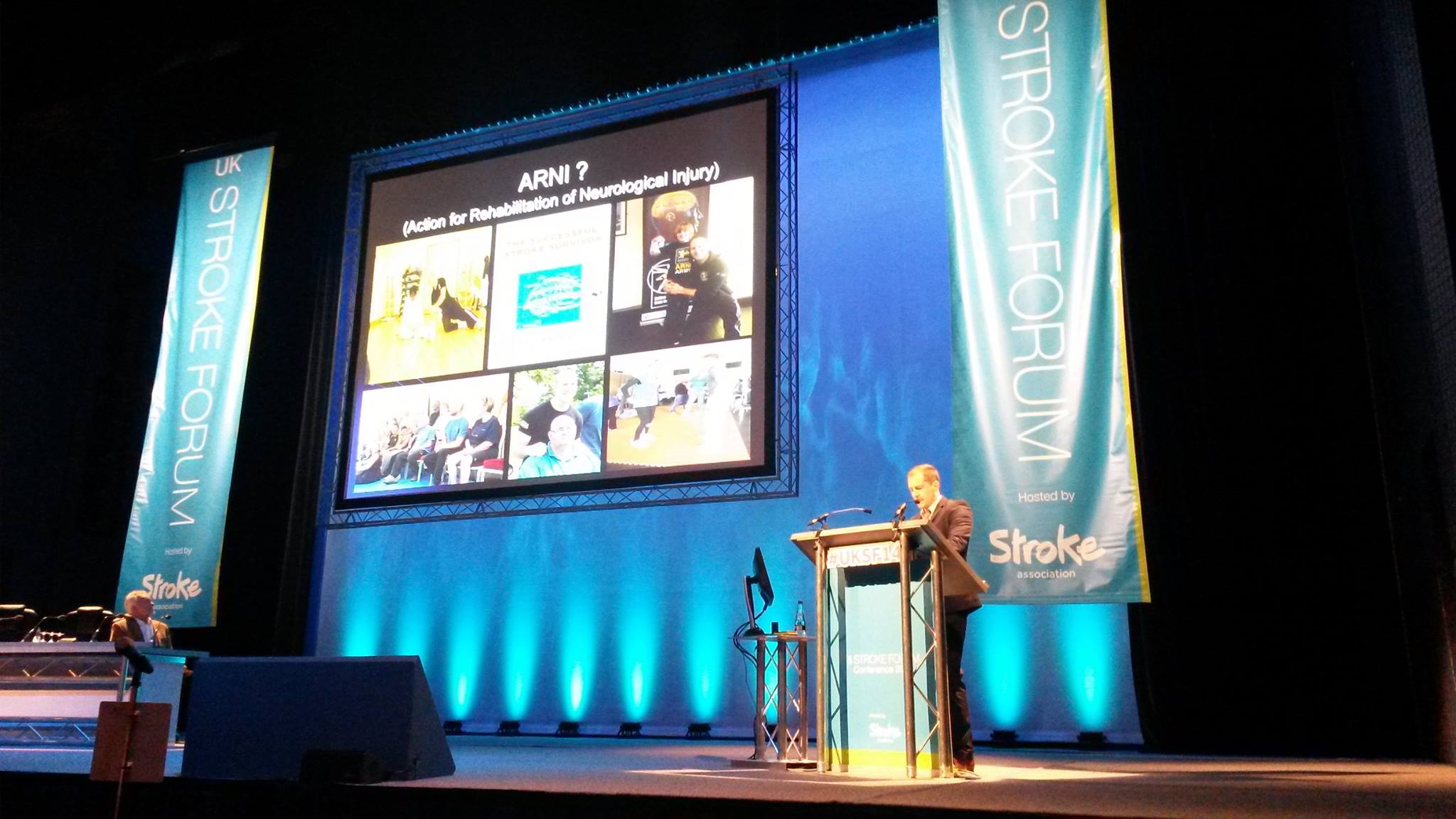 a) Traditional physiotherapy can become unavailable and may not support your more active needs after a while
a) Traditional physiotherapy can become unavailable and may not support your more active needs after a while
Physiotherapy is essential in the acute, chronic and rehabilitative phases of stroke. But it is a sad fact that continuation of effective rehabilitation is generally unavailable from the Health Services once sufficient movement to move around has been achieved. In the UK, NHS neurophysiotherapists and occupational therapists are often simply stretched too thin. Physiotherapy cannot go on forever, and the work they do often is undermined by issues like ‘learned non-use of limbs’ (which is negative neuroplasticity in action) and confidence issues.
Yet the degree to which brain repair, neurogenesis and neural rewiring happens can be enhanced for a significantly long period after the short therapeutic window after stroke, where most return of function is seen. The regain of quality of movement with action control, strength, stability and essential physical coping strategies are highly individual, relying as they do on many factors such as age, attitude (drive, persistence, desire and motivation) and co-morbidity (status of medical complications you brought into your stroke), the status of current accompanying medical problems which require drugs (such as for epilepsy).. and many other reasons.
Great physiotherapists don’t want to ‘keep’ you for longer than you need to have them take care of you. They need you to rehabilitate in the community, and do more of the same kind of work that they have been doing with them (but by yourself, in a structured way) so that you can be creative, adapt and grow. In fact, some of the 37% of senior physiotherapists in the UK, who are using an eclectic mix of their own hybrid nature to help stroke survivors, find that they can identify a clear point when they find themselves needing to advise clients to move on (ie, their job is done).
You need support long after neurophysiotherapy has finished. Many stroke survivors report that they are left with photocopies of training ‘exercises’ to do, many of which they may have plateaued on anyway. These concerns have been echoed in the research for some time. Many physiotherapists feel strongly that there is a certain point where it is the patient who must take charge and self-rehabilitate.
i) RESEARCH shows: Both home-based visits and outpatient exercise programmes can improve gait speed but declines by three months after intervention ceases. In other words, gains do not stay. Although they would tend to if you are shown/guided how progressively to ‘self-retrain’/add in repetitions per day by yourself, in a safe way, to optimise the ‘dosage’ of rehab work that is being achieved. Which means you need to be shown what to do by a qualified and competent trainer or therapist so that you’re helping yourself during the time he/she isn’t there with you.
ii) RESEARCH shows: The effects of physiotherapy programmes on social participation and quality of life are inconsistent – which may be because these issues are complex or that later therapy does not always integrate underlying problems with day to day functioning in the real world.
iii) RESEARCH shows: Much physiotherapy in the rehabilitative stages still results in the stroke survivor doing too little, for fear of ‘doing it wrong’ or developing abnormal compensatory strategies.
iii) RESEARCH shows: Stretching muscles alone does not work for long term neuroplastic change.
This is all important information to know, for it highlights a possible failing at the end of the physiotherapy process (through no fault of the hospitals) where patients are not only left in limbo, but are left in danger of sliding backwards because further support is unavailable. This may well result in a classic vicious circle (particularly when trying to conquer spasticity), where you end up back in hospital due to a fall, because you tried to take risks. Yet you MUST take risks in order to attempt to rewire your brain. Remember that increased movement, capability and decreased spasticity are two sides of the same coin. Clearly, a rehabilitation programme after the chronic stages MUST not only examine how increase function but also how to maintain any gains achieved.
b) The newest studies are showing that neither effortful activities nor strength training, per se, exacerbate spasticity.
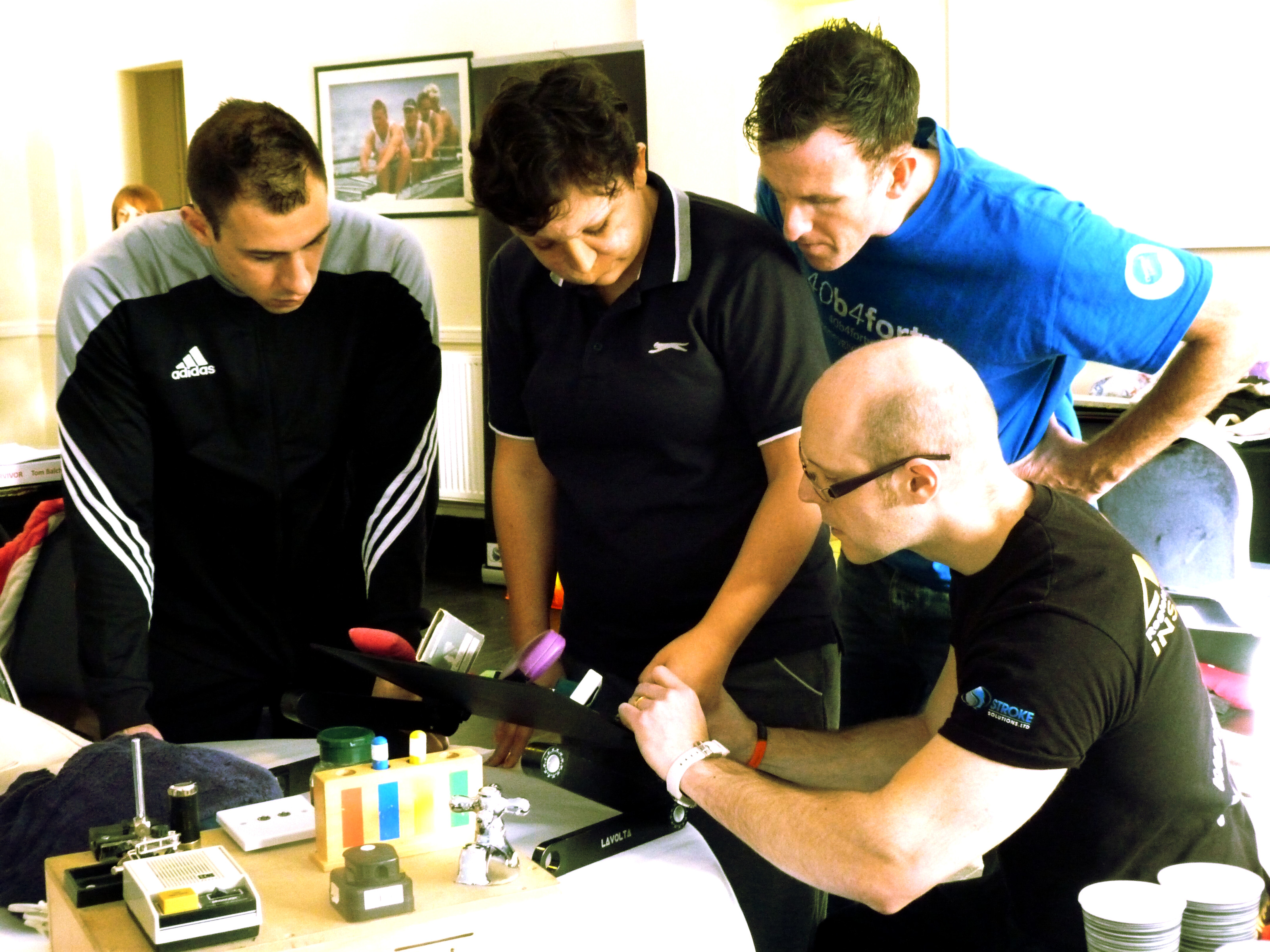 Traditionally, high exertion activities were considered inappropriate for persons with post-stroke hemiparesis because excessive effort was thought to exacerbate spasticity. However, this perception is increasingly being challenged in the contemporary neurological research literature.Actually, the systematic reviews in stroke have now confirmed because effort re-establishes cortical control over spastic muscles, spasticity is actually reduced.
Traditionally, high exertion activities were considered inappropriate for persons with post-stroke hemiparesis because excessive effort was thought to exacerbate spasticity. However, this perception is increasingly being challenged in the contemporary neurological research literature.Actually, the systematic reviews in stroke have now confirmed because effort re-establishes cortical control over spastic muscles, spasticity is actually reduced.
In a systematic review of 151 studies by (Van Peppen et al., 2004) there was found insufficient evidence that traditional neurological treatment methods were effective in improving muscle strength, synergies, muscle tone, dexterity, or ADLs after stroke.
Dutch researchers Kollen, Kwakkel & Lindeman in 2006 reviewed ALL available published (clinical) stroke rehabilitation trials, of which at the time of writing there existed 735. They selected 151 studies including 123 randomized controlled trials and 28 controlled clinical trials. The rest did not in their consideration meet the inclusion criteria or lacked statistical and internal validity, reflecting the poor methodological quality of many clinical intervention studies. This does not concern us too much – I’m just giving you the background picture to let you know how comprehensive the review is.
They stated that such traditional treatment approaches induce improvements that are confined to impairment level only and do not generalize to a functional improvement level. In contrast, they stated that: ‘more recently developed treatment strategies that incorporate compensation strategies with a strong emphasis on functional training, may hold the key to optimal stroke rehabilitation’. In summing up their findings, they reported that ‘intensity and task-specific exercise therapy are important components of such an approach’.
There is a good range of interventions with strong evidence of both efficacy and effectiveness now: Cochrane reviews have found that electromechanical gait training, treadmill training, circuit training, physical fitness training, repetitive task training, CIMT, mirror therapy and FES are effective. Have a look at all of these. You’ll notice that all of these interventions require you DO something. Basically to stimulate neuroplasticity, you have to do repetitive training, learn coping strategies and get stronger. The ARNI Approach guides you to all of this. You can buy the manual showing all of the techniques we use here: GET MANUAL
The ARNI system was grown instinctively over fifteen years ago using many of these principles – specifically functional task-related movement training, creating individual physical coping strategies and performing stroke-specific strength training as fundamental tenets.
Medical professionals and stroke researchers around the world are currently highlighting a necessity for you to rehabilitate in the manner you will find in this programme. This is cutting edge ‘experimental’, aligned with the current theories of brain plasticity. ARNI has a whole new manual of innovative techniques for working at the edges of your current ability, which, allied with hard work, will transform you. You can learn to cope with falls (the most dangerous part of the off-balanceness that stroke causes). You can learn to get down to, and up from, the floor. You can learn to turn 90 and 180 degrees quickly and safely. You can learn to go down steps and ramps safely. You can learn to pick up a book and turn its pages, etc. So how is this all done?
c) Stroke survivors in the UK find it very hard to locate stroke classes which promote active task-related functional movement and resistance training.
Most after-stroke classes that do exist are unable to provide people with the tools to effectively cope with the rigours of daily life, let alone the overwhelming sense of physical inadequacy that keeps people firmly inside their comfort zones. This is particularly difficult if extra problems persist such as epilepsy or aphasia. This is because such classes normally place great emphasis on meeting/socialising. This is great, these meetings are very valuable. However, the impression can easily and frustratingly be given that post re-hab, you have do just do the best you can with what you have. But this is not so.
There are very few accessible sources from which to find out how to go about regaining actual movement. There exist exercise classes in the UK for stroke survivors, but they routinely play safe, focus on socialising, don’t push you hard and don’t show you how to push yourself hard.
The switched-on stroke survivor knows that no improvements in function are going to come easy, and is prepared to work hard. But, given the serious paucity of innovative approaches towards stroke rehab in this country, begins to wonder if nothing is out there which is really going to really work.
So what do you do, and which of the sources do you assess to be worthwhile? How do you know what is effective? If you see something that looks effective in another domain, how do you evaluate whether it will work for stroke rehab, or just be a waste of time? Basically, there is so much misinformation out there and most of it is not worth a jot for real-life transformation. Many of you will be aware of the mass of partial information and anecdotal evidence floating about, especially on internet sites. How do you weed though all of it?
How are you going to make the choice to try something new when most of it is so costly and there are no guarantees of success? We appreciate that it’s very difficult. But the human brain is an absolutely extraordinary self-healing mechanism that once activated in the right ways, with the right attitude, can perform miracles.
4) What to do now:
 I encourage you to do the research for yourself if you can, and find out for yourself that traditional approaches to stroke rehabilitation are becoming outmoded right now as we are finding out more and more about the brain’s capacity for plasticity. Then, you need to consider aligning yourself with instruction that encourages a hands-off approach – encouraging YOU to do the techniques to yourself, positively reinforcing the neurological messages. Remember: cells that fire together, wire together.
I encourage you to do the research for yourself if you can, and find out for yourself that traditional approaches to stroke rehabilitation are becoming outmoded right now as we are finding out more and more about the brain’s capacity for plasticity. Then, you need to consider aligning yourself with instruction that encourages a hands-off approach – encouraging YOU to do the techniques to yourself, positively reinforcing the neurological messages. Remember: cells that fire together, wire together.
Then, make a note that ARNI Instructors are full time professional personal trainers and therapists carefully selected by the ARNI Institute. Some have degrees in neurorehabilitation. All have a wide degree of experience working with diverse populations. They have all gone through the ARNI Institute Functional Rehabilitation & Exercise Training After Stroke Course and regularly keep up their professional development training with ARNI, which we give for all trainers 6 times per year. They now must charge for their services to cover their costs. However, this way, you will have dedicated professional trainer come and train you in your house or you may decide to travel to their area. You will also have the option of working in a stroke group when your ARNI Trainer has enough stroke survivors to create a group class.
Please look further into our site, and especially at the testimonials from past and existing ARNI clients and their carers/family and testimonials from the Instructors who have been through our courses.
If you feel that you could benefit from contact with our UK team or know someone else who would, then please contact us for consideration and evaluation.


